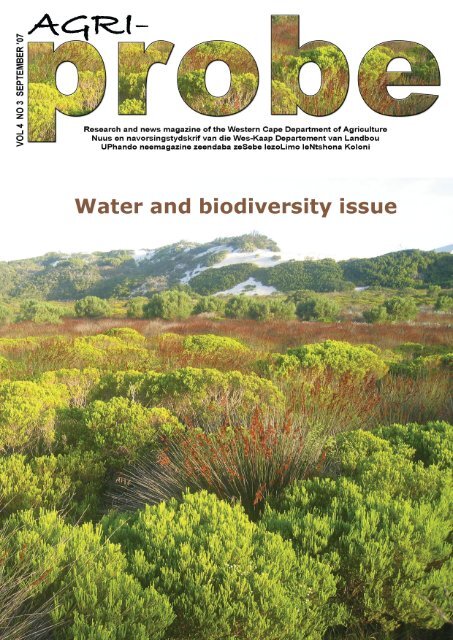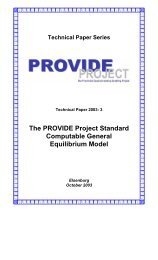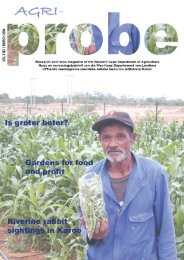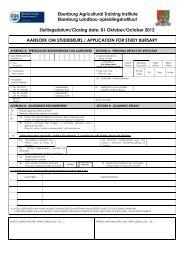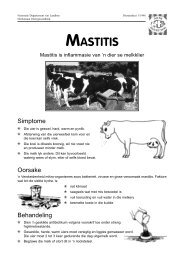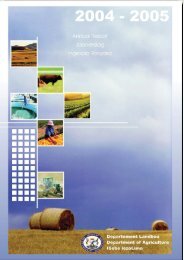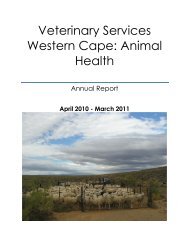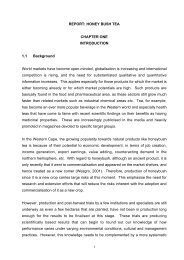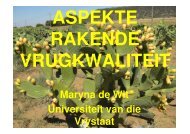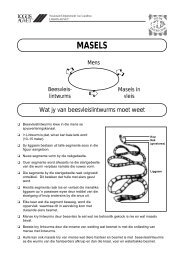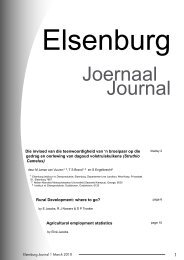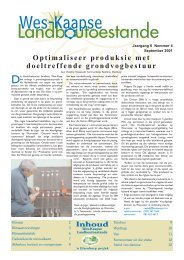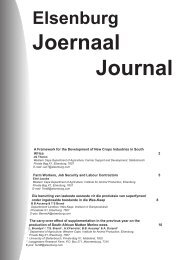Download AgriProbe - Department of Agriculture: Western Cape
Download AgriProbe - Department of Agriculture: Western Cape
Download AgriProbe - Department of Agriculture: Western Cape
You also want an ePaper? Increase the reach of your titles
YUMPU automatically turns print PDFs into web optimized ePapers that Google loves.
1<br />
AgriPROBE September 2007
ditorial<br />
REdaksioneel<br />
AgriPROBE<br />
is quarterly distributed by the <strong>Western</strong> <strong>Cape</strong><br />
Dis lente! Wanneer ’n mens luister na die<br />
berigte van ’n besonderse ryk blommejaar<br />
so teen die Weskus af na ’n lekker nat winter,<br />
is dit moeilik om te glo dat daar ’n watertekort<br />
is. Eweneens klink aardverwarming skielik nie te<br />
onaangenaam wanneer ons lywe begin vra na ’n<br />
bietjie warmte na die koue van die winter nie.<br />
Maar niemand, en veral nie ons in die landbousektor,<br />
behoort meer die gevolge van klimaatsverandering<br />
te misken <strong>of</strong> ignoreer nie. Daar is<br />
natuurlik diegene wat die hele gedoente beskou<br />
as blote rammelinge van doempr<strong>of</strong>ete wat uit die<br />
situasie wil geld maak – byna soos die Y2K-episode van destyds. Wat ons<br />
wel weet is dat die Wes-Kaap ’n waterskaars provinsie is en dat ons meer<br />
ge reeld ekstreme weerstoestande soos droogtes en vloede kan verwag.<br />
Die kwessie van ’n verwagte styging in die gemiddelde temperatuur sal<br />
ook impakteer op die tipe gewasse wat in sekere gebiede verbou kan<br />
word. Die landbou sal dus sekere aanpassings moet maak ter wille van<br />
sy voortbestaan.<br />
For this reason the <strong>Western</strong> <strong>Cape</strong> <strong>Department</strong> <strong>of</strong> <strong>Agriculture</strong> has<br />
launched a Waterwise and Biodiversity Campaign to highlight its contribution<br />
to the search for sustainable solutions. The core message: you CAN<br />
farm AND conserve! The exciting and proactive satellite project with which<br />
the <strong>Department</strong> is involved (page 4) will ultimately aim to increase the<br />
water use efficiency <strong>of</strong> farmers. And then we have long since realised the<br />
importance <strong>of</strong> creating partnerships. We very much agree with Alexander<br />
Graham Bell who said: “Great discoveries and improvements invariably<br />
involve the cooperation <strong>of</strong> many minds”. Our involvement in the Agulhas<br />
Biodiversity Initiative (page 12) is an excellent example where sharing<br />
expertise and resources has resulted in a sustainable success story.<br />
In the history <strong>of</strong> the world great wars have been fought over the issue<br />
<strong>of</strong> access to water. Let us not approach this situation as a war between<br />
those that need water for nature or agriculture <strong>of</strong> simply for drinking. Let<br />
us wisely share what is available while actively joining the search for solutions.<br />
“Man - despite his artistic pretensions, his sophistication, and his<br />
many accomplishments - owes his existence to a six inch layer <strong>of</strong><br />
topsoil and the fact that it rains.” – Unknown author<br />
Charlene Nieuwoudt<br />
Redakteur<br />
If you need any <strong>of</strong> the articles in this magazine in any other <strong>of</strong>ficial language <strong>of</strong> the <strong>Western</strong><br />
<strong>Cape</strong>, we would be happy to arrange translation for you. Please contact the Editor on Tel. 021<br />
808 5008.<br />
Indien u enige van die artikels in hierdie tydskrif in een van die ander amptelike tale van die<br />
Wes-Kaap benodig, kan u ons gerus kontak om die vertaling daarvan vir u te reël. Kontak die<br />
redakteur by Tel. 021 808 5008.<br />
Ukuba ufuna naliphina inqaku elikule magazini ngolunye ulwimi olusesikweni kwiilwimi zeNtshona<br />
Koloni, siya kukulungiselela uguqulelo-lwimi lenqaku elo. Nceda ke uqhagamshelane<br />
noMhleli kule nombolo yomnxeba:- 021 808 5008.<br />
AgriPROBE September 2007<br />
<strong>Department</strong> <strong>of</strong> <strong>Agriculture</strong> free <strong>of</strong> charge to<br />
subscribers.<br />
EDITORIAL<br />
Charlene Nieuwoudt (Editor)<br />
Liesl Muller<br />
Dr Ilse Trautmann<br />
ADVERTISEMENTS<br />
Gizelle van Wyk<br />
Tel. (021) 808 5022<br />
E-mail: gizellevw@elsenburg.com<br />
ADDRESS<br />
Private Bag X1<br />
ELSENBURG<br />
7607<br />
Tel (021) 808 5008<br />
Fax (021) 808 5000<br />
E-mail: charlenen@elsenburg.com<br />
REPRODUCTION<br />
CREDA COMMUNICATIONS<br />
PRINTING<br />
CREDA COMMUNICATIONS<br />
Subscriptions<br />
For free subscription to this quarterly magazine<br />
<strong>of</strong> the <strong>Western</strong> <strong>Cape</strong> <strong>Department</strong> <strong>of</strong> <strong>Agriculture</strong>,<br />
forward your details to Magriet de Lange at:<br />
Tel (021) 808 7613<br />
Fax (021) 808 7605<br />
E-mail magrietadl@elsenburg.com<br />
ISSN: 1810-9799<br />
2
ndex<br />
Inhoudsopgawe<br />
3<br />
Partnerships to preserve<br />
biodiversity ... p. 12<br />
Photograph by Douglas Eustace-Brown<br />
SPESIALE ARTIKELS SPECIAL FEATURES<br />
4 Satellite images show water efficiency<br />
7 Provide shade for reproducing ewes<br />
8 Aquaponics: using waste water for pr<strong>of</strong>it<br />
10 Climate change: Fact <strong>of</strong> Fantasy?<br />
11 Partnerships to preserve biodiversity<br />
16 Wild wild western <strong>Cape</strong><br />
14 Ostrich nutrition<br />
BROKKIES BITS AND PIECES<br />
8 Dr Do-lots: Sewellyn Davey receives Soga<br />
medal<br />
15 Partnerships in training<br />
17 Koebeeberg kry water<br />
20 Clippings<br />
ELSENBURG JOERNAAL / JOURNAL<br />
2 Breaking <strong>of</strong> seed dormancy in three Monocotyledonous<br />
weed species by plant growth regulators<br />
Martha M. Manoto, M.I. Ferreira and G.A. Agenbag<br />
6 Herbicide vs brush-cutting for the control <strong>of</strong> Pteronia<br />
paniculata<br />
N Saayman & JC Botha<br />
9 Nuwejaars Wetland Ecosystem<br />
Hennis Germishuys<br />
Water and land, the two major natural resources<br />
which form the basis for farming, are under<br />
pressure from non-agricultural development initiatives<br />
and the climate change phenomenon. These factors,<br />
combined with the economic outlook for the sector,<br />
are forcing the <strong>Western</strong> <strong>Cape</strong> <strong>Department</strong> <strong>of</strong> <strong>Agriculture</strong> to<br />
re-look different initiatives and to focus on the generation<br />
<strong>of</strong> appropriate and sustainable information and technologies<br />
regarding these themes for our clients.<br />
“The protection and optimal use <strong>of</strong> agricultural water is<br />
one <strong>of</strong> the top priorities <strong>of</strong> the <strong>Department</strong>,” says Joyene<br />
Isaacs, head <strong>of</strong> department. “The <strong>Department</strong> will run a<br />
water wise and biodiversity campaign as one <strong>of</strong> our key<br />
deliverables for this year to promote the efficient use <strong>of</strong><br />
irrigation water, prevent pollution and promote sustainable<br />
use <strong>of</strong> the agricultural resources <strong>of</strong> land, water and air.<br />
Our existing projects which for example promote efficient<br />
water use by the agricultural sector by both commercial<br />
and emerging farmers will continue and be extended. We<br />
also focus on the protection <strong>of</strong> our scarce water resources<br />
from pollution with animal waste by providing planning and<br />
design services for animal husbandry.”<br />
The water use by the urban sector constitute a substantial<br />
portion <strong>of</strong> the water use in the province and some<br />
interesting water facts and water saving tips will also be<br />
presented, with special emphasis on the youth, who are<br />
the adults <strong>of</strong> tomorrow and can make an enormous contribution<br />
to water conservation in the province.<br />
The protection and sustainable use <strong>of</strong> our natural resources<br />
<strong>of</strong> water and land are enhanced by the implementation<br />
<strong>of</strong> LandCare projects that have the aim <strong>of</strong> promoting<br />
AgriPROBE September 2007
Satellite<br />
images show<br />
water use<br />
efficiency<br />
Water is a critical resource in the <strong>Western</strong><br />
<strong>Cape</strong> and there is strong competition<br />
between the urban, industrial<br />
and agriculture sectors within the catchment<br />
area that provide water to the <strong>Cape</strong> Metropole.<br />
Irrrigated agriculture is responsible for<br />
43% <strong>of</strong> the water usage from surface<br />
water resources and the efficient use<br />
<strong>of</strong> irrigation water is critical. Effective<br />
and efficient use <strong>of</strong> irrigation water<br />
is one <strong>of</strong> the top priorities <strong>of</strong> the<br />
<strong>Department</strong> <strong>of</strong> <strong>Agriculture</strong> and a<br />
water conservation project was<br />
launched in 1999 to determine<br />
the water use efficiency <strong>of</strong> crops<br />
in certain areas. Over a period<br />
<strong>of</strong> four years, this project resulted<br />
in an increase in water<br />
use efficiency (kg <strong>of</strong> fruit<br />
produced per cubic meter <strong>of</strong><br />
water) <strong>of</strong> between 15 and<br />
20%. This in-field monitoring<br />
however requires extensive<br />
personnel and financial<br />
resources and a more cost<br />
effective method to reach<br />
the same objectives had to<br />
be found.<br />
The use <strong>of</strong> satellite imagery<br />
provided the opportunity<br />
and a pilot project was embarked<br />
upon with the appointment<br />
<strong>of</strong> the CSIR in Stellenbosch and<br />
Waterwatch in the Netherlands. The study<br />
sustainable resource management and concentrate on<br />
poverty alleviation, capacity building and awareness. Area<br />
Wide Planning <strong>of</strong> large areas within the <strong>Western</strong> <strong>Cape</strong> is a<br />
holistic and pro-active planning tool to link the farm plans<br />
with area plans that reflect the future desired condition<br />
<strong>of</strong> the resources within the Province - see p. 12 for more<br />
information.<br />
AgriPROBE September 2007<br />
aims at spatially estimating water use efficiency in table<br />
and wine grapes in <strong>Western</strong> <strong>Cape</strong> with remote sensing<br />
technology.<br />
The Surface Balance Algorithm for Land (SEBAL) is<br />
used to estimate total evapotranspiration (ET) and water<br />
use efficiency for grapes in the Hex River Valley, Worcester,<br />
Franschhoek and Paarl areas for two growing seasons<br />
(September 2004 to April 2005; September 2005 to April<br />
2006). SEBAL uses the simplified energy balance to the<br />
estimate total evapotranspiration (ET), biomass production,<br />
water deficit and soil moisture spatially. Land surface<br />
characteristics such as surface albedo (earth surface’s<br />
reflectivity), leaf area index, the vegetation index and<br />
surface temperature are derived from satellite imagery.<br />
In addition to satellite images SEBAL requires meteorological<br />
data (wind speed, humidity, solar radiation and air<br />
temperature). Since SEBAL uses the energy balance, and<br />
not the water balance, no data on land cover, soil type or<br />
hydrological conditions are required.<br />
Biomass, Harvest index and Yield calculation<br />
Biomass production calculated by SEBAL can be defined<br />
as the total dry matter production by a plant (roots, stems,<br />
leaves and fruit.<br />
The harvest index (HI) <strong>of</strong> grapes is the part <strong>of</strong> the<br />
biomass that is harvested. This index was found to be a<br />
function <strong>of</strong> water deficit in February and soil moisture content<br />
in November and December. The HI function for table<br />
grapes was developed in this study and is based on field<br />
measurements <strong>of</strong> yield <strong>of</strong> the Alphonse Lavalee cultivar<br />
grown in the Hex River Valley.<br />
The harvest index (HI) <strong>of</strong> wine grapes were developed<br />
based on field measurements <strong>of</strong> yield from the Colombar<br />
grape cultivar grown in the Worcester area. It is dependent<br />
on the water deficit in February and the soil moisture<br />
content in November and December. The wine grape yield<br />
function needs to be improved to include more cultivars<br />
as very different management strategies are applied in the<br />
production <strong>of</strong> different wine grape cultivars.<br />
The estimates <strong>of</strong> evapotranspiration and yield were<br />
used to calculate water use efficiency (WUE in kg <strong>of</strong> fruit<br />
per m 3 ) <strong>of</strong> table and wine grapes. Water use efficiency (or<br />
water productivity) is thus defined as the marketable crop<br />
yield per unit <strong>of</strong> actual total evapotranspiration.<br />
Two ASTER images were acquired. These images<br />
have a spatial resolution <strong>of</strong> 15 x 15m per pixel and are<br />
therefore very suitable for orientation during the fieldwork<br />
and for vineyard mapping. Images <strong>of</strong> Landsat 5-TM and<br />
Landsat 7-ETM (30 X 30 m pixels) were obtained, one<br />
per month for the 2004/05 and 2005/06 irrigation season<br />
We’re serious about saving water .... are you?<br />
continued from p. 3<br />
The campaign will run from September to December<br />
2007 and will focus on the youth, as well as the farming<br />
and broader communities but the focus on resource conservation<br />
is a long term commitment for the <strong>Department</strong><br />
and the various programmes and projects will continue<br />
long after the campaign has ended.<br />
4
(September to April), to be used for the determination <strong>of</strong><br />
the various parameters required.<br />
A team from WaterWatch collected field data from 2<br />
981 grape vineyards, <strong>of</strong> which 2 042 were table grape<br />
vineyards, 894 wine grape vineyards and 39 bush grape<br />
vineyards, to be use for field validation in the Hex River<br />
Valley, Worcester, Franschhoek, Paarl and Wellington.<br />
To compute the spatially distributed ET (evapotranspiration)<br />
<strong>of</strong> grape yield and grape ET, it is necessary to<br />
have an estimate <strong>of</strong> air temperature, air humidity, wind<br />
speed, rain fall and solar radiation for every Landsat pixel.<br />
WaterWatch has developed the MeteoLook algorithm that<br />
interpolates point data on the basis <strong>of</strong> physiographical<br />
properties. The data <strong>of</strong> the 20 automatic ARC weather<br />
stations was used as calibration input to MeteoLook. The<br />
data <strong>of</strong> the 85 mechanic ARC stations and 17 SA Weather<br />
stations was used for validation <strong>of</strong> the MeteoLook results.<br />
The following results were obtained<br />
through the project:<br />
Water consumption <strong>of</strong> vineyards<br />
The distribution and quantity <strong>of</strong> rain in a specific year play<br />
a meaningful role in the water consumption <strong>of</strong> crops. Low<br />
rainfall was recorded in the winter <strong>of</strong> 2004/05, resulting in<br />
limited availability <strong>of</strong> water for the irrigation season. More<br />
than average rain was however recorded in the following<br />
summer, which reduced the irrigation demand. During<br />
2005/06 more rain fell during the winter but very little rain<br />
fell during the summer months, resulting in more water<br />
available from storage during the irrigation season and a<br />
5<br />
André Roux (Pr Eng)<br />
Sustainable Resource Management<br />
E-mail: AndréR@elsenburg.com<br />
higher irrigation demand due to the dry summer.<br />
• Table grapes clearly consume more water than wine<br />
grapes.<br />
• Wine grapes in both studied years consumed a conservative<br />
amount <strong>of</strong> water, with averages <strong>of</strong> 533 mm<br />
(2004/05) and 575 mm (2005/06). This reflect a 7,8%<br />
(43 mm) increase. Irrigation field measurements in Hex<br />
Valley agree with these results, showing irrigation supplies<br />
increase by 69 mm in the second season.<br />
• Table grapes’ water consumption however increased<br />
with 18% from 702 to 828 mm which is equivalent to an<br />
increment <strong>of</strong> 126 mm.<br />
• What draws the attention is that not all farmers were<br />
able to increase their irrigation during the dry season<br />
(2005/06), resulting in more variation in table grapes’<br />
water consumption.<br />
• One explanation for the lower increase in irrigation for<br />
wine grapes may be that over-irrigation in red wine<br />
grapes affects the quality <strong>of</strong> wine. For table grapes<br />
and white wine grapes however, extra irrigation mainly<br />
results in a higher yield.<br />
• A good correlation exist between the accumulative<br />
monthly evapotranspiration in the fields calculated with<br />
SEBAL and evapotranspiration calculated with the soil<br />
water balance based on field measurements.<br />
Water use efficiency<br />
Water use efficiency was fairly similar in the two study<br />
seasons. Water use efficiency <strong>of</strong> table grapes decreases<br />
slightly from 3.8kg/m 3 on average to 3.7kg/m 3 in the<br />
AgriPROBE September 2007
second year, while<br />
the water use efficiency<br />
<strong>of</strong> wine<br />
grapes shows a<br />
small drop from<br />
4.9 kg/m 3 to 4.5<br />
kg/m 3 on average.<br />
Water use<br />
efficiency in the Hex<br />
Valley in the second season<br />
is lower in most areas due to<br />
slightly lower yields and significantly<br />
higher water consumption.<br />
Especially in the downstream<br />
area, water use efficiency drops<br />
during the second year. In the more<br />
isolated table grape vineyards (in<br />
the southeast and east, most likely<br />
from farmers with their own water<br />
resources), water use efficiency<br />
remains preserved or even improves.<br />
Many factors however play a role such as the variability<br />
<strong>of</strong> soil type, both in terms <strong>of</strong> physical and chemical<br />
properties.<br />
Many conclusions can be reached from the project<br />
results but due to limited space, only a few will be highlighted.<br />
• Water use efficiency <strong>of</strong> grapes in <strong>Western</strong> <strong>Cape</strong> is in<br />
general quite good, although it varied considerably<br />
between fields, regions and between years.<br />
• The considerable spatial variation in WUE in the grape<br />
producing areas, suggest that WUE can be improved.<br />
• Spatial estimates <strong>of</strong> WUE can be used to evaluate differences<br />
in management practices and suggest improvements.<br />
• Water use efficiency is influenced by many factors. The<br />
availability <strong>of</strong> water per farm (access to ground water<br />
and storage capacity) and management <strong>of</strong> water in<br />
times <strong>of</strong> scarcity play an important role.<br />
• The production objectives influence the water use ef-<br />
AgriPROBE September 2007<br />
A satellite image from Google Earth and Waterwatch showing water use efficiency<br />
in the Worcester area.<br />
ficiency. High quality red wine grapes require less water<br />
that high yielding vineyards producing grapes for the<br />
brandy industry.<br />
• Variations in water use efficiencies in Hex Valley are<br />
very large. This can partly be contributed to the large<br />
number <strong>of</strong> cultivars grown.<br />
• The varieties Dauphine, Thompson, Barlinka and<br />
Crimson have highest water use efficiencies, while the<br />
varieties Victoria and Flame have relatively low water<br />
use efficiencies.<br />
• It seems that farmers with their own water resources at<br />
the outskirts <strong>of</strong> the area are able to manage their water<br />
resources better, resulting in higher water use efficiencies.<br />
It is recommended that the study be extended to include<br />
the potato growing areas <strong>of</strong> the Sandveld, the grape<br />
producing areas <strong>of</strong> Vredendal and the citrus producing<br />
areas <strong>of</strong> Clanwilliam and Citrusdal.<br />
Recommendations for further studies include incorporating<br />
more years to evaluate the influence <strong>of</strong> rainfall on<br />
water consumption, and to make inter-annual evaluation<br />
possible. It is necessary to study more than two years to<br />
better express temporal variability and the role <strong>of</strong> reliable<br />
water supplies.<br />
It is also recommended to collect more spatially varied<br />
field data on yield in future studies. The wine yield model<br />
in this study was based on Worcester field data only, while<br />
yields are very different in Paarl area.<br />
The datasets produced are highly relevant for the<br />
growers and their irrigation advisors. Combination <strong>of</strong> the<br />
remote sensing data with vineyard management expertise<br />
will create a good avenue for better explaining the causing<br />
factors <strong>of</strong> the strong variations in water use efficiency in<br />
both space and time. Grower associations could benefit<br />
from having geographically different values <strong>of</strong> yield<br />
(income), water (conservation) and water use efficiency<br />
(utilisation and sustainability). Targets could be established<br />
for improving fields with low water use efficiency,<br />
for better future control <strong>of</strong> the spatial variation in water use<br />
efficiency.<br />
6
For the extensive small grain cropping industry in the<br />
<strong>Western</strong> and Southern <strong>Cape</strong> to become viable, the<br />
natural vegetation (including all the trees and the<br />
shrubs) had to be removed. The trees occurring naturally<br />
in the <strong>Western</strong> <strong>Cape</strong> are all slow growers. This resulted<br />
in foreign trees (like Eucalyptus) being planted to provide<br />
shade in the few places it was desired. However, plantings<br />
were limited, because <strong>of</strong> the shade the tall Eucalypts<br />
casted on adjacent crops, and also because <strong>of</strong> a “dead<br />
zone” in the root area <strong>of</strong> these plants. Trees and other<br />
structures for the provision <strong>of</strong> shade to extensive livestock<br />
is therefore largely absent in the cropping areas <strong>of</strong> the<br />
<strong>Western</strong> and Southern <strong>Cape</strong>.<br />
Against this background we provide results <strong>of</strong> a study<br />
on the provision <strong>of</strong> shade to sheep in the Swartland cropping<br />
area.<br />
The study was conducted at the Langgewens Research<br />
Station <strong>of</strong> the <strong>Western</strong> <strong>Cape</strong> <strong>Department</strong> <strong>of</strong><br />
<strong>Agriculture</strong> between Malmesbury and Moorreesburg. The<br />
climate at the experimental site is Mediterranean, and<br />
78% <strong>of</strong> the total long-term annual precipitation <strong>of</strong> 395 mm<br />
is recorded during winter (normally lasting from April to<br />
September). The Swartland area is characterised by dry,<br />
hot and windy summers. Long term weather data indicate<br />
that average monthly temperatures exceeding 30°C are<br />
common during the period from December to February.<br />
Merino ewes annually lambed in eight paddocks <strong>of</strong><br />
approximately 1ha each from 1996 to 1998. Data <strong>of</strong> 497<br />
ewes and their <strong>of</strong>fspring were recorded. The ewes were<br />
adapted to the paddocks for two weeks prior to the com-<br />
Provide shade<br />
for reproducing<br />
ewes<br />
7<br />
mencement <strong>of</strong> lambing usually by about 20 February each<br />
year. They remained in the paddocks throughout lambing,<br />
and for an extra 14-21 days prior to lambmarking, usually<br />
towards the end <strong>of</strong> April. Shade structures were erected<br />
in four <strong>of</strong> the paddocks, while the other four paddocks<br />
served as controls. Shade structures consisted <strong>of</strong> corrugated<br />
iron ro<strong>of</strong>s, mounted on the top <strong>of</strong> six wooden posts.<br />
The ro<strong>of</strong> area <strong>of</strong> the structures was 3x4 m, and the ro<strong>of</strong>s<br />
were elevated to 1.8 meter above ground level. Water meters<br />
were installed in the water supply line to all paddocks.<br />
This allowed the measurement <strong>of</strong> water consumption on a<br />
per paddock basis. Concentrate and roughage consumption<br />
were recorded similarly. This allowed the calculation<br />
<strong>of</strong> water and feed intake on a per ewe basis. Birth weight,<br />
survival to weaning and weaning weight were recorded for<br />
individual lambs.<br />
Average feed intake on a paddock basis was not affected<br />
by shading treatment (1.505kg/ewe/day in control<br />
paddocks vs. 1.504kg/ewe/day in paddocks with shade<br />
structures). The lack <strong>of</strong> response in feed intake between<br />
the shaded and control groups could possibly be ascribed<br />
to cooler environmental conditions at night when animals<br />
were able to maintain a normal feed intake. Ewes kept in<br />
control paddocks without shade drank 26% more water<br />
during the experimental period than sheep in paddocks<br />
with shade (3.878 vs. 3.076l/ewe/day respectively).<br />
Casual observations <strong>of</strong> the behaviour <strong>of</strong> sheep with and<br />
without access to shade indicated that most ewes stayed<br />
in the shade with their lambs from about 10:00 until late afternoon.<br />
They moved out <strong>of</strong> the shade for varying intervals<br />
AgriPROBE Photo: September Schalk 2007 Cloete
Provide shade for reproducing<br />
ewes<br />
continued from p. 7<br />
AQUAPONICS<br />
using waste water for pr<strong>of</strong>it<br />
Aquaculture in South Africa has not yet realised its<br />
full potential due to the fact that traditional agricultural<br />
industries have always been pervasive on the<br />
South African agricultural landscape. Another reason why<br />
opportunities for aquaculture are <strong>of</strong>ten overlooked is due<br />
to the fact that South Africa is basically a semi-arid country<br />
with relatively low rainfall. This lack <strong>of</strong> water could make it<br />
difficult to sustainably produce fish commercially.<br />
There is a need to shift to sustainable aquaculture<br />
practices using newer technologies that will optimise the<br />
use <strong>of</strong> water. One approach would be to integrate the<br />
aquaculture system with other agriculture based industries.<br />
Aquaponics, which integrates hydroponics (growing<br />
plants without soil) with aquaculture (fish farming), is a<br />
good example <strong>of</strong> a potentially successful integration.<br />
The integration <strong>of</strong> fish and plants increases diversity<br />
and thereby enhances system stability. Aquaponics can<br />
also be used to produce large quantities <strong>of</strong> food in very<br />
small spaces in an environmentally friendly way. The prin-<br />
usually to feed or drink water.<br />
Lambs born in paddocks where shade was provided<br />
tended to be heavier at birth than contemporaries born in<br />
control paddocks (3.87 vs. 3.77kg respectively). It has to<br />
be conceded that the pregnant ewes were subjected to the<br />
respective treatments for only a short period <strong>of</strong> approximately<br />
2 weeks before lambing started. The positive effect<br />
<strong>of</strong> shade on lamb birth weight could<br />
possibly have been enhanced<br />
if the animals were subjected<br />
to the experimental<br />
conditions over a longer<br />
period, particularly during<br />
January and the<br />
earlier part <strong>of</strong> February<br />
as well. The<br />
latter months are<br />
regarded as being<br />
the months with<br />
the highest maximum<br />
temperatures<br />
at the experiment<br />
site. In overseas<br />
studies, it was<br />
AgriPROBE September 2007<br />
ciple <strong>of</strong> the integrated system is to optimise the utilisation<br />
<strong>of</strong> nutrients derived from aquaculture for agricultural use.<br />
Since 1987, an integration <strong>of</strong> aquaculture and agriculture<br />
has been investigated in South Africa to introduce fish<br />
and vegetable production in the same system.<br />
This aquaculture model has been well practised in<br />
developed countries such as Asia. In South Africa it could<br />
be established if sufficient expertise can be built for technology<br />
transfer. A farm at Saasveld (George) is practicing<br />
aquaponics at present. The system has been operating<br />
since 2004. It is a closed recirculating system where<br />
breakdown products derived from the fish wastes is used<br />
as a nutrient source for the plants within the system.<br />
Selecting the suitable fish species for an aquaponics<br />
system is very important. In aquaponics the fish and plants<br />
selected for aquaponic system should have similar needs<br />
as far as temperature and pH is concerned. Catfish and<br />
tilapia were selected for production at Saasveld. As a general<br />
rule, warm water fish and leafy crops such as lettuce<br />
and herbs will do the best, however fruiting plants such as<br />
found that chronic heat stress during pregnancy is associated<br />
with foetal growth retardation, resulting in a decline<br />
in lamb birth weight, and an impairment <strong>of</strong> the viability <strong>of</strong><br />
lambs. However, the survival <strong>of</strong> lambs was not improved<br />
by the provision <strong>of</strong> shade in this experiment, as climatic<br />
conditions were not extreme. Lambs born in shaded paddocks<br />
were 3.8% heavier at weaning than those born in<br />
control paddocks (21.9 vs. 21.1 kg respectively).<br />
The provision and distribution <strong>of</strong> drinking water for<br />
livestock is a major challenge on cropping farms in the<br />
<strong>Western</strong> and Southern <strong>Cape</strong>. According to the results <strong>of</strong><br />
this study, the water needs <strong>of</strong> a 1000 ewe flock may be<br />
reduced by >800l/day over the summer period, simply by<br />
providing shade to reproducing ewes. Shade also had a<br />
beneficial effect on the growth <strong>of</strong> lambs to weaning, while<br />
results from the literature suggested that it would also<br />
benefit birth weight and survival under more extreme climatic<br />
conditions, as are occasionally experienced in South<br />
Africa.<br />
Predictions regarding global warming suggest that<br />
the <strong>Western</strong> <strong>Cape</strong> could become prone to more extreme<br />
climatic conditions and fluctuations in future.<br />
A study to quantify the effects <strong>of</strong> natural tree shade on<br />
the production and welfare <strong>of</strong> extensive sheep flocks is<br />
being planned, because <strong>of</strong> these evident benefits listed<br />
above, and also because <strong>of</strong> the alleged impact <strong>of</strong><br />
climate change in the foreseeable<br />
future.<br />
Dr Carel Muller & Pr<strong>of</strong> Schalk Cloete<br />
Institute for Animal Production<br />
CarelC@elsenburg.com; SchalkC@elsenburg.com<br />
8
Refiloe Thobejane, Institute for animal produc tion<br />
9<br />
tomatoes and peppers will also be viable, depending on<br />
the stocking density <strong>of</strong> the fish in a system.<br />
Factors that make catfish and tilapia suitable candidates<br />
for aquaponics:<br />
• Tilapia is a warm-water species that grows well in a recirculating<br />
tank culture. Furthermore, tilapia is tolerant<br />
<strong>of</strong> fluctuating water conditions such as pH, temperature<br />
and dissolved oxygen. Catfish is also a suitable candidate<br />
because <strong>of</strong> tolerant to overcrowding and a poor<br />
water quality.<br />
• Plants that will do well in any aquaponics system include<br />
any leafy lettuce, spinach, basil, mint and chives.<br />
• Plants that have higher nutritional demands and will<br />
only do well in a heavily stocked and well established<br />
aquaponic system include tomatoes, peppers, cucumbers,<br />
beans and peas.<br />
How does Aquaponics Work?<br />
In aquaponics, the nutrient-rich waste-water from recirculating<br />
aquaculture provides a food source for the growing<br />
plants and the hydroponic beds provide a natural filter for<br />
the water fish live in. Gravity drains the water back to the<br />
fish dams. This creates an ecosystem where both plants<br />
and fish can thrive. Aquaponics is the ideal answer to a<br />
fish farmer’s problem <strong>of</strong> disposing <strong>of</strong> nutrient rich water<br />
and a hydroponic grower’s need for nutrient rich water.<br />
The main objective being to investigate the most<br />
efficient application <strong>of</strong> integration <strong>of</strong> aquaculture with agriculture<br />
by utilizing nutrient rich water discharged from<br />
recirculating system to irrigate vegetable crops.<br />
Refiloe Thobejane<br />
Institute for Animal Production<br />
e-mail: RefiloeT@elsenburg.com<br />
Doctor Do-lots:<br />
Sewellen Davey receives Soga medal<br />
Dr. Sewellyn Davey, State Veterinarian at Mooreesburg,<br />
recently received the Soga medal for exemplary<br />
community service, not only in her state<br />
vet area, but also to the<br />
veterinary community <strong>of</strong><br />
the <strong>Western</strong> <strong>Cape</strong>, which<br />
she has faithfully served as<br />
honorary Secretary <strong>of</strong> the<br />
<strong>Western</strong> <strong>Cape</strong> Branch <strong>of</strong> the<br />
SA Veterinarian Association<br />
and Livestock Health and<br />
Production Group for the<br />
past two decades.<br />
Apart from serving<br />
communities, Sewellyn<br />
demonstrates her<br />
empathy and care<br />
to individuals in a very tangible way, such as an incident<br />
recently with the illegal movement <strong>of</strong> a pony into the Animal<br />
Horse Sickness surveillance area. Biscuit had been<br />
purchased for the 6 th birthday <strong>of</strong> a girl who suffers from<br />
mitochondrial neuromuscular dystrophy and weighs 16<br />
kg. She has always wanted a horse and as she had been<br />
able to remain out <strong>of</strong> hospital for more than 6 months, her<br />
parents bought her this horse. The Equine Practitioners<br />
Group is in the process <strong>of</strong> laying a charge against the<br />
seller as he wrongly informed the girls parents that no<br />
special requirements or permits were needed to bring the<br />
horse to them in the Malmesbury district. Biscuit was sent<br />
<strong>of</strong>f to stand quarantine in the protection zone, leaving a<br />
very sick girl extremely disappointed. Sewellyn went out <strong>of</strong><br />
her way to find a replacement. A very kind farmer is lending<br />
the girl a pregnant mare called “Ruby Red” and she<br />
will be able to keep the foal.<br />
Dr Sewellyn Davey, State Veterinarian at the Moorreesburg Office.<br />
AgriPROBE September 2007
What<br />
you<br />
can do<br />
right<br />
now<br />
AgriPROBE September 2007<br />
Climate change:<br />
fact or fantasy?<br />
Many people believe that climate change is not a proven threat to<br />
civilisation, but the <strong>Western</strong> <strong>Cape</strong> <strong>Department</strong> <strong>of</strong> <strong>Agriculture</strong> agrees<br />
that it is a very serious phenomenon which will severely impact on<br />
the farming community. One <strong>of</strong> the <strong>Department</strong>’s contributions is the current<br />
(and continued) focus on water and the environment via the Waterwise and<br />
Biodiversity Campaign. This article serves as a very brief overview from different<br />
experts on the topic as well as a list <strong>of</strong> practical actions to help you, the<br />
farmer, limit the impact <strong>of</strong> climate change.<br />
The scientists quoted are Dr Guy Midgley and Pr<strong>of</strong>. Bruce Hewitson.<br />
For those <strong>of</strong> you who are confused and bewildered by the force <strong>of</strong> emotion<br />
and passion that some bring to the issue, here are a few facts<br />
• “Climate change is nothing new; it’s all happened before.” The answer to<br />
that is, yes it has, but neither in the same way nor to the same degree.<br />
• Yes, rapid climate change has occurred in the past, but the critical point is<br />
that global mean temperature has oscillated for many hundreds <strong>of</strong> thousands<br />
<strong>of</strong> years between a frigid glacial level <strong>of</strong> below 10 0 C and the balmy<br />
interglacial levels <strong>of</strong> 14-15 0 C during interglacials.<br />
• Human-induced climate change will cause this level to be exceeded<br />
sometime in the next 50 years. And further increases into new temperature<br />
soil<br />
• Maintain as much soil cover as<br />
possible (cover crops, mulch)<br />
• Manage veld and riparian areas<br />
• Introduce and maintain diversity <strong>of</strong><br />
plant life and habitats that will maintain<br />
diversity <strong>of</strong> all other life.<br />
• Manage, reduce and rehabilitate<br />
erosion. (re-plant, use gabions and<br />
swales)<br />
• Increase soil life and organic matter<br />
• Reduce tillage to an absolute minimum<br />
• Minimise the use <strong>of</strong> chemical fertilisers with the aim <strong>of</strong> nil usage.<br />
• Replace chemical fertilisers with compost, cover and sacrificial crops,<br />
humus, worms, microbial life, natural mined minerals.<br />
• Store surplus water (earth dams, rain<br />
tanks on all buildings)<br />
water<br />
• Re-direct water run<strong>of</strong>f (swales, canals,<br />
ponds)<br />
• Avoid water run-<strong>of</strong>f (cover-plants,<br />
mulching)<br />
• Recycle (grey water from houses, factories,<br />
etc)<br />
• Investigate desalination<br />
• Reduce/avoid evaporation (Cover water storage areas where possible).<br />
• Bury all water pipes to reduce evaporation, leaks, and sun damage.<br />
10<br />
l<br />
u<br />
w<br />
u
territory will continue for several decades beyond if we<br />
do not curb greenhouse gas emissions. The cool Earth<br />
?<br />
to which most <strong>of</strong> our natural species and existing farming<br />
practices has evolved will become warm enough to<br />
be outside the evolutionary experience <strong>of</strong> many species<br />
and unable to sustain current farming practices.<br />
• Modern industrial agriculture is one <strong>of</strong> the biggest contributors<br />
to the rapid advance <strong>of</strong> human-induced climate<br />
change<br />
• People that deny climate change is happening <strong>of</strong>ten<br />
say: “If you can’t predict the weather next week how<br />
can anyone predict climate in a few decades, right?”<br />
This argument confuses weather with climate. (It’s said<br />
that if you don’t like the weather, then wait till tomorrow<br />
– but if you don’t like the climate, get ready to relocate).<br />
Two years ago the <strong>Western</strong> <strong>Cape</strong> suffered a serious<br />
drought, leading to the declaration <strong>of</strong> a “State <strong>of</strong> Emergency”<br />
by the Premier <strong>of</strong> the <strong>Western</strong> <strong>Cape</strong>. The Premier,<br />
in collaboration with other provincial Ministers and heads<br />
<strong>of</strong> departments, decided that the <strong>Department</strong> <strong>of</strong> Environmental<br />
Affairs and Development Planning must undertake<br />
a response study on climate change in the <strong>Western</strong> <strong>Cape</strong><br />
to understand climate change and its effects on the <strong>Western</strong><br />
<strong>Cape</strong> as well as develop a response mechanism. Dr<br />
Guy Midgley, Chief Specialist Scientist for SANBI Climate<br />
Change Group, led this study, which confirmed that the<br />
<strong>Western</strong> <strong>Cape</strong> is being impacted by climate change.<br />
land<br />
use<br />
water<br />
• Anticipate reduced quantity<br />
<strong>of</strong> water available for<br />
irrigation<br />
• Schedule according to<br />
usage<br />
plant demand.<br />
• Use soil moisture probes<br />
and irrigate according to<br />
need.<br />
• Maintain irrigation systems<br />
(remove from dead<br />
plants, fix leaks)<br />
• Design an optimal system (use drip irrigation where possible)<br />
• Deep mulch and irrigate less.<br />
• Planning for change – site, crop and cultivar selection, row direction<br />
• Change the micro-climate - e.g. Shade-netting, evaporative cooling,<br />
reflective particle film<br />
11<br />
• Climate change,organic<br />
and biological farming,<br />
awareness workshops and<br />
farmer mentoring<br />
• Sustainable harvesting<br />
<strong>of</strong> wild rooibos, medicinal<br />
plants, fuelwood and restios<br />
as thatching material<br />
The physics <strong>of</strong> climate change are indisputable, evident<br />
in atmospheric carbon dioxide, global temperature<br />
increases, Arctic changes and changes in rainfall trends.<br />
Model based studies attribute this to anthropogenic actions.<br />
The change manifests as:<br />
• increase in mean temperature<br />
• increase in variance <strong>of</strong> temperature<br />
• increase in mean and variance, resulting in less<br />
change for cold weather (2005 was the warmest year on<br />
record, the last eight years were the warmest in the last<br />
100, and the last century was the warmest in the last 1200<br />
years).<br />
<strong>Western</strong> <strong>Cape</strong> trends are not simply about becoming<br />
drier or wetter; it’s a complex situation. For example,<br />
areas that are predominantly dependent on cold fronts are<br />
getting drier. But with increased humidity, fynbos captures<br />
more water in the mountains. Trends indicate increases<br />
in rainfall intense events, reduced total rainfall in the west<br />
and increased orographic rainfall towards the east. Not<br />
just change in averages, but also change in extremes.<br />
Changes occur in space and time and place stress on all<br />
facets <strong>of</strong> the infrastructure and capacity <strong>of</strong> society.<br />
There exists considerable scientific agreement about<br />
the pattern <strong>of</strong> change but uncertainty about the magnitude<br />
there<strong>of</strong>.<br />
natural<br />
environment<br />
• Remove invasive alien plants<br />
& other organisms and restore<br />
natural habitat<br />
• Establish shelter belts, maintain<br />
& protect wildlife & natural areas<br />
• Use good agricultural practices<br />
that include crop rotation and<br />
reduction <strong>of</strong> the use <strong>of</strong> harmful<br />
chemicals<br />
• Greening using indigenous species to create beneficial microclimates<br />
• Wise use <strong>of</strong> biodiversity e.g. sustainable harvesting<br />
• More efficient use <strong>of</strong> energy and fuel switching to more sustainable<br />
fuels<br />
• Replace old diesel engines, the cause <strong>of</strong> major pollution<br />
• Change to renewable energy (wind power, solar power, biomass,<br />
micro-hydro)<br />
catchment<br />
areas<br />
organisms<br />
• Maintain biodiversity and soil<br />
cover<br />
• Appropriate fire management<br />
• Erosion control and restoration<br />
• Wetland and riparian zone conservation<br />
& restoration<br />
• Control invasive alien plants &<br />
AgriPROBE September 2007
Land use on the<br />
Agulhas Plain<br />
Hennis Germishuys<br />
Landcare<br />
HennisG@elsenburg.com<br />
AgriPROBE September 2007<br />
Partnerships to<br />
preserve<br />
biodiversity<br />
“<strong>Cape</strong> Agulhas!” Another busload <strong>of</strong> tourists disgorges at the candy-striped lighthouse,<br />
jostling to have their photographs taken at the southern tip <strong>of</strong> the continent <strong>of</strong><br />
Africa. In recent years, the list <strong>of</strong> reasons why people choose to visit the Agulhas Plain<br />
has been growing steadily: whale watching, shark cage diving, the fynbos, local history,<br />
culture and crafts. Both directly and indirectly, biodiversity is proving vital to the<br />
local economy. Eco-tourism is growing rapidly and the harvesting <strong>of</strong> fynbos wildflowers<br />
is currently one <strong>of</strong> the largest industries on the Agulhas Plain. In this predominantly<br />
rural area with up to 50% unemployment, the Agulhas Biodiversity Initiative (ABI)<br />
is investigating how to use the region’s biodiversity in a sustainable manner so that it<br />
can benefit local communities in the long term.<br />
The Agulhas Plain stretches from the Klein River in the west to the Breede River<br />
in the east, covering 270 000 ha <strong>of</strong> coastal lowlands and hills that stretch northwards<br />
towards the mountains. The diversity <strong>of</strong> indigenous fynbos and Renosterveld plants is<br />
enormous: <strong>of</strong> the 2 500 species that occur here, 100 are endemic to the Agulhas Plain<br />
and about 112 are found on the Red Data list. Originally, the Agulhas Plain supported<br />
large herds <strong>of</strong> game, and 72 <strong>of</strong> the 81 species <strong>of</strong> terrestrial mammals that occurred in<br />
the <strong>Cape</strong> Floristic Region were found here. Some species like blue buck, quagga and<br />
<strong>Cape</strong> lion are now extinct and today many species are found only in protected areas<br />
like De Hoop Nature Reserve and Agulhas National Park.<br />
Programmes like the Agulhas Biodiversity Initiative rely on the cooperation and effective<br />
participation <strong>of</strong> a number <strong>of</strong> stakeholders. Similarly, provincial and local authority<br />
initiatives require integrated planning across a number <strong>of</strong> sectors. In the Overberg,<br />
role players have come up with a strategy to help them operate in a more integrated<br />
and efficient way.<br />
The <strong>Department</strong> <strong>of</strong> <strong>Agriculture</strong> and SANParks have entered into a Memorandum<br />
<strong>of</strong> Co-operation, which is currently being expanded to include <strong>Cape</strong>Nature. One <strong>of</strong><br />
the outcomes <strong>of</strong> this agreement is the establishment <strong>of</strong> the Bredasdorp Multipurpose<br />
Centre, a “one-stop shop” that can potentially house stakeholders from a number<br />
<strong>of</strong> government departments, including the <strong>Department</strong> <strong>of</strong> <strong>Agriculture</strong>, SANParks,<br />
<strong>Cape</strong> Nature, DEADP, DWAF, <strong>Department</strong> <strong>of</strong> Land Affairs, local authorities and social<br />
welfare organisations.<br />
Establishing the Agulhas National Park<br />
In the early 1990s, SANParks started investigating the establishment <strong>of</strong> a National<br />
Park on the Agulhas Plain. In 1996, the SANParks Board approved the declaration <strong>of</strong><br />
the Agulhas National Park (ANP), which incorporated conservation priority areas that<br />
had been identified in the IPC study. SANParks planned to purchase 26 000 ha <strong>of</strong><br />
land outright and to enter into contractual arrangements with landowners to incorporate<br />
a further 44 000ha. The consolidation <strong>of</strong> the Agulhas National Park is proceeding<br />
as planned.<br />
The <strong>Department</strong> <strong>of</strong> <strong>Agriculture</strong> – A key partner<br />
Trust is at the heart <strong>of</strong> all successful negotiations, especially when they involve<br />
landowners and government. On the Agulhas Plain, attempts to get farmers to sell<br />
their land to SANParks resulted in some landowners feeling uneasy about the<br />
intentions <strong>of</strong> State conservation agencies. In an area where most <strong>of</strong> the land is<br />
zoned agricultural, the <strong>Department</strong> <strong>of</strong> <strong>Agriculture</strong> has become a significant roleplayer<br />
in biodiversity conservation efforts, in particular through its LandCare:<br />
Area Wide Planning (AWP) programme.<br />
LandCare is a programme <strong>of</strong> the <strong>Department</strong> <strong>of</strong> <strong>Agriculture</strong> that aims to<br />
maintain and restore healthy, productive agricultural land through integrated<br />
12
natural resource management, capacity building and partnerships. Through a process<br />
known as Area Wide Planning (AWP), the department works with groups <strong>of</strong> farmers<br />
to develop sustainable land management plans at a sub-regional level. These plans<br />
take into account the issues, needs and opportunities identified by the group and are<br />
linked to municipal Integrated Development Plans (IDPs). Through the AWP process,<br />
groups <strong>of</strong> farmers can identify projects and seek funding from LandCare and the local<br />
municipality.<br />
One <strong>of</strong> the functions <strong>of</strong> AWP is fine-scale farm planning. The <strong>Department</strong> <strong>of</strong> <strong>Agriculture</strong><br />
works with landowners to identify zones on their properties that are suitable for<br />
different land uses. In rural areas, the distinction is made between priority agricultural<br />
land and priority conservation land. Through the CAPE programme fine-scale (1:10<br />
000) biodiversity maps have been prepared for the Agulhas Plain indicating the vegetation<br />
types and areas that are most critically in need <strong>of</strong> conservation. The <strong>Department</strong><br />
<strong>of</strong> <strong>Agriculture</strong> uses these maps during AWP and farm planning exercises, and can<br />
therefore recommend not only which parts <strong>of</strong> the farm are most suitable for grazing,<br />
crops and infrastructure, but also which areas should be managed for biodiversity.<br />
Feedback from the biological surveys undertaken during the 1990s reaffirmed what<br />
many farmers in the area already knew: the Agulhas Plain was a biodiversity treasure.<br />
Rather than seeing this as a threat to their farming operations, some landowners<br />
recognised that conservation <strong>of</strong>fered them opportunities to diversify and improve their<br />
incomes. Once they knew which terrestrial and wetland habitats should be conserved,<br />
they could set these aside and continue farming on the less critical sections <strong>of</strong> their<br />
properties. The conservation areas then became an eco-tourism draw-card.<br />
By integrating agricultural and conservation planning in this way, the <strong>Department</strong> <strong>of</strong><br />
<strong>Agriculture</strong> is helping to implement the ecosystem approach to biodiversity conservation<br />
in a practical way on the Agulhas Plain.<br />
Dune asteraceous fynbos on the Agulhas Plain. Not the typical fynbos view.<br />
All photographs used with kind permission <strong>of</strong> Agulhas National Park, photograph by<br />
Douglas Euston-Brown.<br />
13<br />
Spot on!<br />
On the 5 km 2 site where Eskom<br />
planned to construct<br />
a nuclear power station<br />
45 plant species endemic<br />
to the Agulhas Plain were<br />
found, including four site<br />
endemics.<br />
AgriPROBE September 2007
Female<br />
Farmer<br />
winners<br />
Janice Jamieson <strong>of</strong> Montagu, Sonja Ferreira <strong>of</strong><br />
Oudtshoorn, the Zola Organic Farming Project <strong>of</strong><br />
Hermanus, the women <strong>of</strong> the Masivuke Garden<br />
in Khayelitsha and Tessa Goslett <strong>of</strong> ABSA Agri business<br />
were proclaimed as the <strong>Western</strong> <strong>Cape</strong>’s top<br />
female farmers or contributors to agriculture during<br />
a gala event on Wednesday, 8 August 2007. The female<br />
farmer <strong>of</strong> the year competition is held to honour<br />
women involved in agriculture – <strong>of</strong>ten in trying circumstances<br />
and within an environment which is mainly male<br />
dominated.<br />
The Top Contributor to <strong>Agriculture</strong> prize this year<br />
went to Tessa Goslett <strong>of</strong> ABSA Agri business for her commitment<br />
and creative involvement to the agricultural sector<br />
and especially women in agriculture. This prize is awarded<br />
by Cobus Dowry, <strong>Western</strong> <strong>Cape</strong> Minister <strong>of</strong> <strong>Agriculture</strong>.<br />
AgriPROBE September 2007<br />
Sonja Ferreira,<br />
Top Producer for National Markets,<br />
started her Tantinki goat farming<br />
enterprise about 9 years ago with<br />
only ten goats, with the idea to sell fresh<br />
goats milk. Today she milks about 120 goats and<br />
produces thirteen different cheeses, as well as butter,<br />
yogurt, ice cream and soap. She will soon be exporting<br />
goat’s milk fudge to England. Her cheese maker<br />
assistant, Stefan Pockpas was recently chosen to<br />
complete a cheese making course in France as part<br />
<strong>of</strong> an exchange programme organised by the <strong>Western</strong><br />
<strong>Cape</strong> <strong>Department</strong> <strong>of</strong> <strong>Agriculture</strong> and Agri Expo<br />
with the French government.<br />
Sonja was also awarded the National Female<br />
Farmer Top Producer for National Markets prize at t<br />
ceremony in Nelspruit recently.<br />
On the insert: Sonja and Lulu Xingwana, Natioanl<br />
Minister for <strong>Agriculture</strong> at the National prize giving<br />
ceremony.<br />
Janice<br />
Jamieson,<br />
winner <strong>of</strong> the category<br />
for Top Producer<br />
for Export Markets,<br />
farms with fourteen<br />
alpacas on their farm<br />
outside Montagu<br />
and markets her<br />
processed products<br />
both locally and<br />
overseas. “Alpaca<br />
wool is extremely<br />
luxurious, 30% warmer<br />
than other fibers and appears in 22 natural<br />
colours,” explains Janice. Her three permanent workers<br />
spin the wool and then produce the most luxurious items<br />
such as scarves, footwear and shawls.<br />
14
The Zola Organic Farming<br />
Project, a group <strong>of</strong> four women from Hermanus,<br />
was awarded the prize for being the Top Producers for<br />
Informal Markets. This group <strong>of</strong> women started their vegetable<br />
garden in 2003 on 800m 2 provided to them by the<br />
Overstrand Municipality. Today they produce a wide range<br />
<strong>of</strong> vegetables organically in small plastic tunnels and supply<br />
to the local SPAR and the community. “We will train<br />
more people to begin food gardens because in that way<br />
more people will have food on the table,” says Margaret<br />
Msomi, the leader <strong>of</strong> the group.<br />
Partnerships in training<br />
The <strong>Western</strong> <strong>Cape</strong> <strong>Department</strong> <strong>of</strong> <strong>Agriculture</strong>, in<br />
partnership with the Burgundy regional Council<br />
<strong>of</strong> France, has been managing a very successful<br />
exchange programme since 2001. The French partners<br />
include the French Embassy to South Africa, Burgundy<br />
Regional Council, Cote d’Or General Council, Dijon Prefecture<br />
and the Wineries/Cheese factories from Burgundy.<br />
The South African partners include the South African<br />
Embassy to France, <strong>Department</strong> <strong>of</strong> <strong>Agriculture</strong>, the South<br />
African Wine Industry Council and South African wineries.<br />
The core focus <strong>of</strong> the programme is the economic empowerment<br />
and social upliftment <strong>of</strong> South African historically<br />
disadvantaged individuals. Other goals include fostering<br />
economic ties, developing inter-cultural exchange<br />
and to ensure the transfer <strong>of</strong> knowledge between Burgundy<br />
and the <strong>Western</strong> <strong>Cape</strong>. A total <strong>of</strong> 67 South African<br />
beneficiaries in the agriculture sector have since received<br />
training through this exchange programme.<br />
Recently the <strong>Department</strong> hosted ten exchange students<br />
from France, Canada and Israel who<br />
received certificates in<br />
wine making<br />
and harvestingpractices<br />
in the<br />
<strong>Western</strong><br />
<strong>Cape</strong>. The<br />
students<br />
participated<br />
in<br />
harvest-<br />
15<br />
Masivuke Community Garden<br />
group from Khayelitsha won the category<br />
for Top Producers for Household Use. This group <strong>of</strong> six<br />
women produces vegetables on a piece <strong>of</strong> school owned<br />
land <strong>of</strong> just 100mx50m. However, their intense community<br />
involvement makes them role models as they share both<br />
their produce and their skills with young people, those<br />
infected with the HIV virus and other poor community<br />
members.<br />
ing activities at ten wine cellars for six weeks as part <strong>of</strong><br />
their training. The students also attend lectures and visit<br />
various wine estates during their stay.<br />
Photograph: Back: Marius Paulse, Chief Director: Structured<br />
Agricultural Training (CIAT), Anne Gye-Jacquot (student);<br />
Front: Carol Levendal, Director <strong>of</strong> Teriary Education<br />
(CIAT), Nicolas Thevenot (student) and Jean-Luc Bodin-<br />
French, Consul (SA).<br />
Closer to<br />
home:<br />
Four students<br />
from<br />
the <strong>Cape</strong><br />
Institute for AgriculturalTraining:<br />
Elsenburg<br />
recently joined<br />
the horticulture<br />
division<br />
at the Agricultural<br />
Research<br />
Council Infruitec-<br />
Nietvoorbij for 3 weeks to participate in<br />
certain research activities. Although it is winter, activities<br />
<strong>of</strong> the research projects on rootstocks <strong>of</strong> pome and stone<br />
fruit include evaluation <strong>of</strong> scion growth and applications<br />
<strong>of</strong> products in the soil health research. The students were<br />
also introduced to olives as an alternative crop. The aim <strong>of</strong><br />
this practical internship is to introduce students to information<br />
on horticultural research activities.<br />
On the photograph: students Zakhele Msimango; Sandisikhaya<br />
Dzula; Natanja du Toit; Megan de Villiers and Ria<br />
Rhode (ARC).<br />
AgriPROBE September 2007
Wild wild western cape<br />
Riaan Nowers & Sanet Briel<br />
It took some time, but at last the <strong>Western</strong> <strong>Cape</strong> is opening<br />
its doors to wildlife activities in a more structured<br />
way, thereby unlocking the Province’s ecotourism<br />
potential. If developed and supported responsibly by all<br />
involved, that is from the landowner to government institutions<br />
and nature conservation <strong>of</strong>ficials, this trend can be<br />
used to develop rural areas which are continuously under<br />
threat <strong>of</strong> depopulation, ageing populations and deteriorating<br />
infrastructure.<br />
This change in land-use, from traditional agricultural<br />
practices to practices enforced by economic realities and<br />
lifestyle changes, promises to have a positive impact on<br />
our Province’s natural resources. Once a landowner and<br />
his employees embark on a road <strong>of</strong> wildlife management/<br />
farming practices, sustainable conservation practices are<br />
essential tosurvive over time. The embracing <strong>of</strong> a holistic<br />
view on species diversity managed at micro level, will<br />
encourage increased ruggedness in ecosystems, thereby<br />
increasing their sustainability to the benefit <strong>of</strong> other agricultural<br />
systems and mankind as a whole. This implies not<br />
only diversity in wildlife species, diversity in habitats, but<br />
also diversity in genetic pools and even diversity in human<br />
skills employed at grass-root levels.<br />
In order to facilitate and monitor these changing landuse<br />
patterns, the <strong>Department</strong> <strong>of</strong> Agirculture recognised<br />
the need for deeper involment and research into these<br />
dynamic practices. The first step in characterising this<br />
industry was to determine the what exactly is happening<br />
at grass root level. A recent survey produced interesting<br />
results, <strong>of</strong> value to this emerging subsector, as well as<br />
to institutions involved. This survey showed that the<br />
<strong>Western</strong> <strong>Cape</strong> wildlife industry experienced rapid<br />
growth the past ten years. At present there are<br />
at least 115 wildlife production units in operation,<br />
covering some 522 282 hectares <strong>of</strong><br />
land. This area amounts to 4, 36% <strong>of</strong><br />
the total area <strong>of</strong> agricul-<br />
AgriPROBE September 2007<br />
tural land in The <strong>Western</strong> <strong>Cape</strong>. Now the question may<br />
be asked whether agricultural research, development<br />
and support institutions spend 4,36% <strong>of</strong> their time, efforts<br />
and money on this sector? This becomes more and more<br />
relevant as the survey further indicated that this industry is<br />
also a positive contributor to employ ment opportunities as<br />
some 565 permanent and 364 temporary jobs can be attributed<br />
directly to wildlife production on agricultural land.<br />
When combining ecotourism ventures to wildlife production<br />
systems, it seems that these systems generate more<br />
jobs per unit land than conventional agricultural systems,<br />
acting as positive job creators. It also seems that the skill<br />
levels <strong>of</strong> employees on these units are higher than those<br />
<strong>of</strong> the typical agricultural businesses in the same area.<br />
This phenomenon however needs further research.<br />
Respondents in the survey made it clear that they<br />
support further research on wildlife systems. The following<br />
topics were identified as areas which in particular are in<br />
need <strong>of</strong> deeper research:<br />
• Species distribution according to habitat;<br />
• Historical species distribution;<br />
• Nutrition;<br />
• Plant distributions and veld condition during various<br />
seasons;<br />
• Stocking rates and carrying capacities;<br />
• Adaptability <strong>of</strong> wildlife species in relocated areas;<br />
• Wildlife diseases;<br />
• Status and handling <strong>of</strong> problem animals; and<br />
• All issues regarding game meat, from marketing to<br />
specific qualities.<br />
The expansion <strong>of</strong> the wildlife industry from both the Northern<br />
and especially Eastern <strong>Cape</strong> is a natural phenomenon<br />
that needs to be nurtured in a<br />
responsible way. Too <strong>of</strong>ten individuals<br />
and some organizations<br />
regard it in a negative way<br />
and disregard the potential<br />
and opportunities available.<br />
What is called for is for all<br />
involved to take hands<br />
and to assist the <strong>Western</strong><br />
<strong>Cape</strong> wildlife industry to<br />
become a true model <strong>of</strong><br />
rational utilisation <strong>of</strong> land,<br />
maximizing the creation <strong>of</strong> jobs,<br />
the empowerment <strong>of</strong> people and<br />
increasing access to natural wildlife<br />
species.<br />
Photograph: Riaan Nowers<br />
16
Ostrich nutrition and<br />
management<br />
17<br />
The ostrich industry is a predominantly South African<br />
industry, which, according to the latest figures provided<br />
by the Ostrich Business Chamber, produces<br />
about 70% <strong>of</strong> all the ostrich products in the world. The<br />
gross value <strong>of</strong> the industry in South Africa is about R 1 200<br />
million per annum, while the feed production industry supplies<br />
feeds to the industry to the value <strong>of</strong> R 600 million per<br />
annum. The ostrich industry is a rapidly growing industry<br />
and markets for leather products with specific qualities are<br />
even extending to the motor industry, while the worldwide<br />
demand for low-fat and low-cholesterol ostrich meat is<br />
ever increasing. However, the industry suffers from a lack<br />
<strong>of</strong> reliable scientific information on the nutritional needs<br />
<strong>of</strong> ostriches, the real nutritive value <strong>of</strong> raw materials for<br />
ostriches as well as reliable nutritional management systems<br />
for ostriches. Variations in feed quality could result<br />
in variations in the quality <strong>of</strong> end products, which could<br />
jeopardise the demand for higher market prices.<br />
Feed prices constitute 70 – 80% <strong>of</strong> the total operational<br />
costs <strong>of</strong> an ostrich production unit, and any increase in reliable<br />
scientific information and management systems will<br />
enhance the pr<strong>of</strong>itability <strong>of</strong> the industry. That alone would<br />
lead to an extension in both the scope <strong>of</strong> opportunities and<br />
the pr<strong>of</strong>itability <strong>of</strong> the industry.<br />
Optimisation growth and feed models have already<br />
been developed overseas, for instance for poultry, turkeys<br />
and pigs, and are used with great success in these<br />
Pr<strong>of</strong> Tertius Brand, Institute for Animal Production<br />
industries all over the world. These models are capable <strong>of</strong><br />
taking into account various biological and animal-related<br />
factors, feed factors and the environment, as well as the<br />
interactions between these factors. A result is then produced<br />
in economic terms, together with a least-cost diet,<br />
to meet the needs <strong>of</strong> the animals at a specific stage to<br />
produce an end product <strong>of</strong> a specific quality as required<br />
by the market at that stage. These techniques will specifically<br />
benefit the ostrich industry, which provides a range<br />
<strong>of</strong> high-quality end products in terms <strong>of</strong> skins with specific<br />
qualities in keeping with market needs, high-priced<br />
cuts <strong>of</strong> meat and feathers (present income ratio <strong>of</strong> about<br />
60:50:10), which will change from time to time in keeping<br />
with market changes.<br />
At present there are no such optimisation models or<br />
feeding systems in the ostrich industry. The end products<br />
<strong>of</strong> the ostrich industry (skins, meat and feathers) are also<br />
different from those in other industries and the same models<br />
cannot be applied. Such technology should, however,<br />
be developed as soon as possible to be applied within the<br />
ostrich industry in order to improve the competitiveness<br />
<strong>of</strong> the ostrich producing and ostrich feed manufacturing<br />
industry.<br />
A savings <strong>of</strong> 10% in feed costs, made possible by the<br />
use <strong>of</strong> an optimisation model and least-cost feed formulation<br />
program with reliable values for feeds, will lead to a<br />
saving <strong>of</strong> more than R55 million per annum for the South<br />
African ostrich industry.<br />
Our research team at the Elsenburg Animal Production<br />
AgriPROBE September 2007
Institute with the help <strong>of</strong> Pr<strong>of</strong> Rob Gous from the University<br />
<strong>of</strong> KwaZulu-Natal is currently busy to develop a mathematical<br />
computer-based optimisation model for ostriches<br />
A brief description <strong>of</strong> the project follows after an indication<br />
<strong>of</strong> the persons and institutions involved.<br />
Practical application <strong>of</strong> optimisation models<br />
Intensive commercial ostrich production deals with decision-making.<br />
The producer’s decision-making is aimed at<br />
maximum pr<strong>of</strong>it out <strong>of</strong> the business. However, decisionmaking<br />
is based on various practical factors, namely<br />
market needs on the one hand and the means at the producer’s<br />
disposal, as well as his own circumstances on the<br />
other hand. The market needs for ostrich products may<br />
be specified in terms <strong>of</strong> leather, meat and feathers. The<br />
producer’s circumstances and the means at his disposal<br />
will, for example, include the following:<br />
• Genotype and growth potential <strong>of</strong> animals<br />
• Production environment<br />
• Potential intake <strong>of</strong> the animals<br />
• Availability, quality and price <strong>of</strong> feed<br />
• Feed processing techniques<br />
• Management practices (e.g. harvesting <strong>of</strong> feathers,<br />
division <strong>of</strong> the sexes during rearing, etc.)<br />
It is possible to link a monetary value to both the market<br />
need and the means at the producer’s disposal. By utilising<br />
the capacity <strong>of</strong> the computer, as well as certain biological<br />
and mathematical principles, it is possible for the<br />
model or computer program to evaluate the information<br />
available and use it to assist the producer in his decisionmaking.<br />
Such a model will then also be adjusted and<br />
improved as research information becomes available.<br />
A broiler model developed by Pr<strong>of</strong>. Rob Gous <strong>of</strong> the University<br />
<strong>of</strong> Natal will be adapted<br />
for the ostrich industry.<br />
In this model<br />
the following<br />
three<br />
aspects<br />
AgriPROBE September 2007<br />
<strong>of</strong> the nutrition program are optimised:<br />
• The amino acid content <strong>of</strong> each feed within a set nutrition<br />
program<br />
• The energy content <strong>of</strong> each feed within a set nutrition<br />
program<br />
• The optimal nutrition program for feeds with a specific<br />
nutritional composition.<br />
Typical information collected to construct the model include<br />
the following:<br />
Biological information<br />
• Growth curves for different breeds and sexes in an<br />
environment where feed intake is unlimited.<br />
• Estimate <strong>of</strong> the body composition (amino acids, fat,<br />
fatty acids, energy value, etc.) <strong>of</strong> the total carcass <strong>of</strong> the<br />
animal at the various growth stages.<br />
• Determination <strong>of</strong> the composition <strong>of</strong> the carcass <strong>of</strong> the<br />
animal at the various stages under different feeding<br />
conditions.<br />
• Determination <strong>of</strong> the separate development <strong>of</strong> the body<br />
components (meat, feathers and skin) <strong>of</strong> birds at different<br />
growth stages.<br />
• Measurement <strong>of</strong> the development <strong>of</strong> all the economically<br />
important end products at various stages <strong>of</strong> development<br />
(e.g. the development <strong>of</strong> the 17 different cuts <strong>of</strong><br />
meat over time, skin size, skin damage, nodule size and<br />
tensile strength <strong>of</strong> the skin over time).<br />
Economic information<br />
• The price <strong>of</strong> the various end products according to quality<br />
criteria<br />
• The price <strong>of</strong> feed components and commercial feed<br />
Management information<br />
• The effect <strong>of</strong> the harvesting <strong>of</strong> feathers on production<br />
• The effect <strong>of</strong> feed processing on production<br />
It is clear that the use <strong>of</strong> computer-based mathematical<br />
models holds great advantages for all commercial animal<br />
production industries. Scientific information on the ostrich<br />
industry is relatively scarce. It is essential<br />
that all scientific information collected in<br />
future be utilised in the best interest<br />
<strong>of</strong> the ostrich industry. The use<br />
<strong>of</strong> optimisation models <strong>of</strong>fers<br />
an excellent technique for<br />
collecting scientific information<br />
and conveying it to<br />
the producer in a practical<br />
and useful form.<br />
By Pr<strong>of</strong>. Tertius<br />
Brand<br />
Institute for<br />
Animal Production<br />
e-mail:<br />
TersB@<br />
elsenburg.<br />
com.<br />
18
Clippings<br />
Silver for Ters<br />
19<br />
Pr<strong>of</strong>essor Tertius Brand, specialist animal researcher<br />
from the <strong>Western</strong> <strong>Cape</strong> <strong>Department</strong> <strong>of</strong> <strong>Agriculture</strong><br />
has recently been awarded a silver medal for his<br />
continued excellence in the field <strong>of</strong> research on nutrition<br />
and feeding systems by the South African Society for Animal<br />
Science (SASAS).<br />
According to the Society Tertius is considered as a<br />
truly leading South African nutritionist with his insight in<br />
complex problems, his innovative nature, his exceptional<br />
work ethics and his excellent record <strong>of</strong> reporting research<br />
to fellow scientists, funding co-ordinators and the general<br />
industry. He is presently regarded as an undisputed world<br />
leader in the field <strong>of</strong> the scientific nutrition <strong>of</strong> ostriches.<br />
As the leader <strong>of</strong> numerous projects on the nutrition <strong>of</strong><br />
ostriches Tertius was able to attract external funding to<br />
the value <strong>of</strong> ±R4.5 million over the past six years. In the<br />
present situation where limited funds is being canalised to<br />
groundbreaking research, this is an achievement. Innovations<br />
stemming from this research include a range <strong>of</strong> near<br />
infrared spectroscopy curves for a range <strong>of</strong> feedstuffs, a<br />
computer model for the prediction <strong>of</strong> the optimum slaughter<br />
age for ostriches, and electronic feed database for<br />
typical South African feeds and a mathematical optimisation<br />
model for the prediction <strong>of</strong> the nutrient requirements<br />
<strong>of</strong> ostriches. He also played a major role in the patenting<br />
<strong>of</strong> a feeding system for the separate feeding <strong>of</strong> male and<br />
female ostrich breeders being maintained as pairs. Innovations<br />
like these are due to revolutionise the scientific<br />
feeding <strong>of</strong> ostriches (see article on p.17).<br />
Navorsers presteer<br />
Annelie Kruger van die program Tegnologie,<br />
Navorsing en Ontwikkeling se<br />
Dierproduksie Instituut op Elsenburg en<br />
Clovis Bhiya, toe nog deel van die Departement<br />
se Young Pr<strong>of</strong>essional program, het onlangs<br />
hulle M Tech Grade van die Nelson Mandela<br />
Metropolitaanse Universiteit op George<br />
ontvang. Annelie is ’n permanente beampte<br />
op Elsenburg, terwyl Clovis onlangs as dosent<br />
by die Kaapse Instituut vir Landbou-opleiding:<br />
Elsenburg aangestel is.<br />
Annelie het die voedingsbestuursaspekte<br />
van volstruise ondersoek, terwyl Clovis na die<br />
ideale slagouderdom vir volstruise gekyk het.<br />
Clovis het ook ’n tr<strong>of</strong>ee vir die beste nagraadse<br />
studie in Landboubestuur van die<br />
Universiteit ontvang en het sy graad cum laude<br />
verwerf.<br />
Landboumanne se rugbyharte klop sterk<br />
Die PANNAR landboukolleges rugbyweek is onlangs<br />
by die Departement se Kaapse Instituut vir Landbou-opleiding:<br />
Elsenburg aangebied. Ten spyte<br />
van ‘n titaniese stryd teen veral Potchefstroom, Saasveld<br />
en Grootfontein, het die Elsenburgspan weer eens met die<br />
louere weggestap as die toernooi se algehele wenners.<br />
Ander kolleges wat deelgeneem het, was Fort Cox (Oos-<br />
Kaap) en Cedara (KwaZulu-Natal).<br />
Mundus van Niekerk van Potchefstroom het die<br />
meeste punte (60) op die telbord geplaas, gevolg deur Andries<br />
van Dyk van Grootfontein (51) en Johann du Plessis<br />
van Elsenburg (46).<br />
AgriPROBE September 2007
www.elsenburg.com<br />
AgriPROBE September 2007<br />
20


